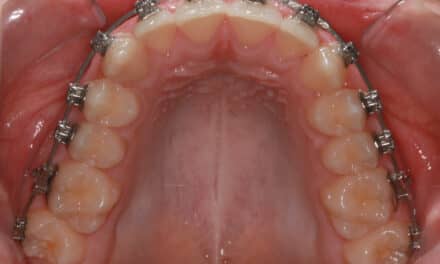According to a summary from DrBicuspid.com, a new study has found that the presence of white spot lestions (WSLs) on orthodontic patients can result in a negative perception of the treating orthodontist by the patient’s general dentist. The study was published in the July issue of the Journal of the American Dental Association.
WSLs remain the most common complication of fixed orthodontic appliance therapy, and can form within 4 weeks, according to the study authors from Virginia Commonwealth University. Good oral hygiene, such as brushing with a toothpaste containing fluoride concentrations of 0.1% or greater, can help prevent WSLs, they noted, and for patients who are not fully compliant, dentists should encourage the use of a fluoride mouth rinse on a daily basis.
For this study, the researchers used a cross-sectional survey design that was sent to general dentists and orthodontists in Virginia, Maryland, and North Carolina. The final sample included 191 general dentists and 305 orthodontists. Two different surveys were sent: one for general dentists and one for orthodontists.
The general dentists answered questions about how often, in the previous year, they had treated WSLs associated with braces, their methods of treatment, and if their perception of the orthodontist is negatively affected by the presence of multiple WSLs.
The researchers asked orthodontists how often, in the previous year, they had removed braces because the patient had poor oral hygiene, and what they recommended to patients with severe WSLs at the debonding appointment.
The findings of the study include the following:
• General dentists reported that a median of 20% of their patients had WSLs associated with braces; orthodontists reported that a median of 10% of their patient had WSLs associated with braces.
• 69% of general dentists and 76% of orthodontists recommended in-office fluoride treatment for patients with severe WSLs immediately after orthodontic treatment.
• 69% of general dentists reported that they had treated WSLs during the previous year; 37% of orthodontists reported that they had removed braces because of patients’ poor oral hygiene.
• General dentists used a variety of methods to treat WSLs, including at-home fluoride rinse, resin-based composite or porcelain veneers, tooth whitening or in-office fluoride, microabrasion, and MI Paste with Recaldent.
• 60% of orthodontists referred patients with severe WSLs to their general dentists for treatment; others recommended at-home fluoride rinse, MI Paste with Recaldent, in-office fluoride, tooth bleaching, prescription fluoride toothpaste, and mild enamel microabrasion.
More than one-third of general dentists indicated that severe WSLs after orthodontic treatment could have a negative effect on their perception of the treating orthodontist. According to the researchers, this is a noteworthy result because general dentists typically are the source of referrals to orthodontists.
“General dentists and orthodontists should work together to prevent the development of WSLs in their patients,” the authors concluded. “Treatment with fluoride supplements and motivating and training patients to practice good oral hygiene will help achieve this goal.”








